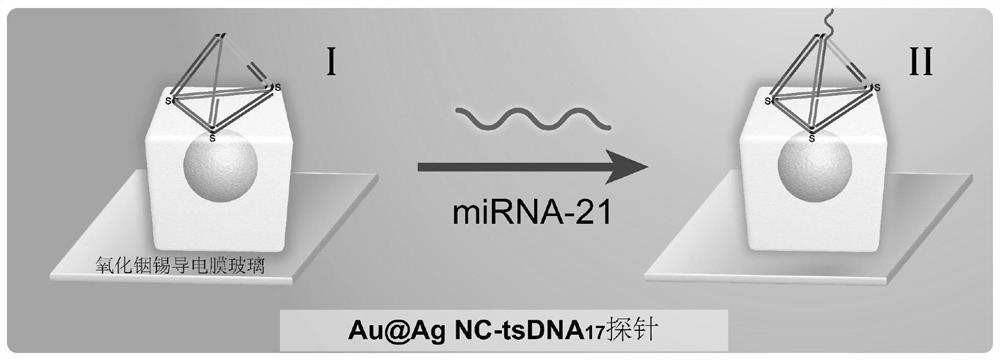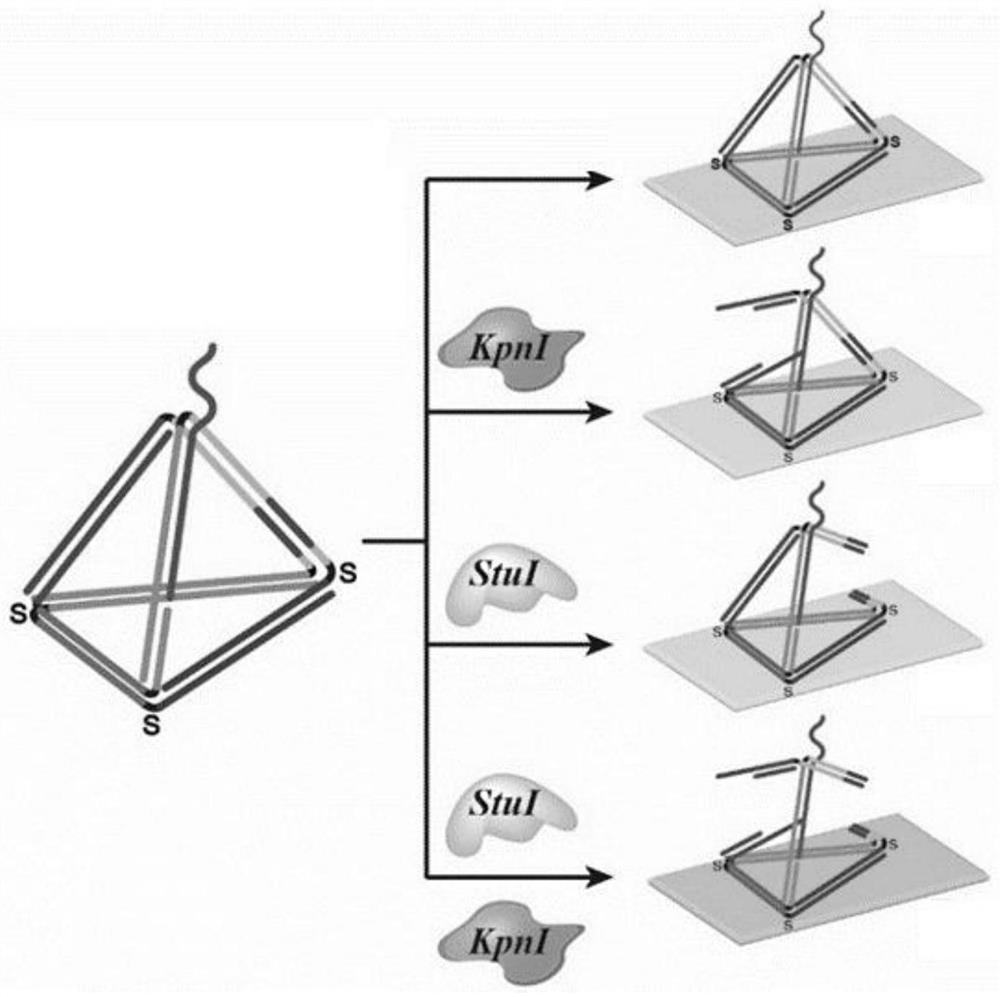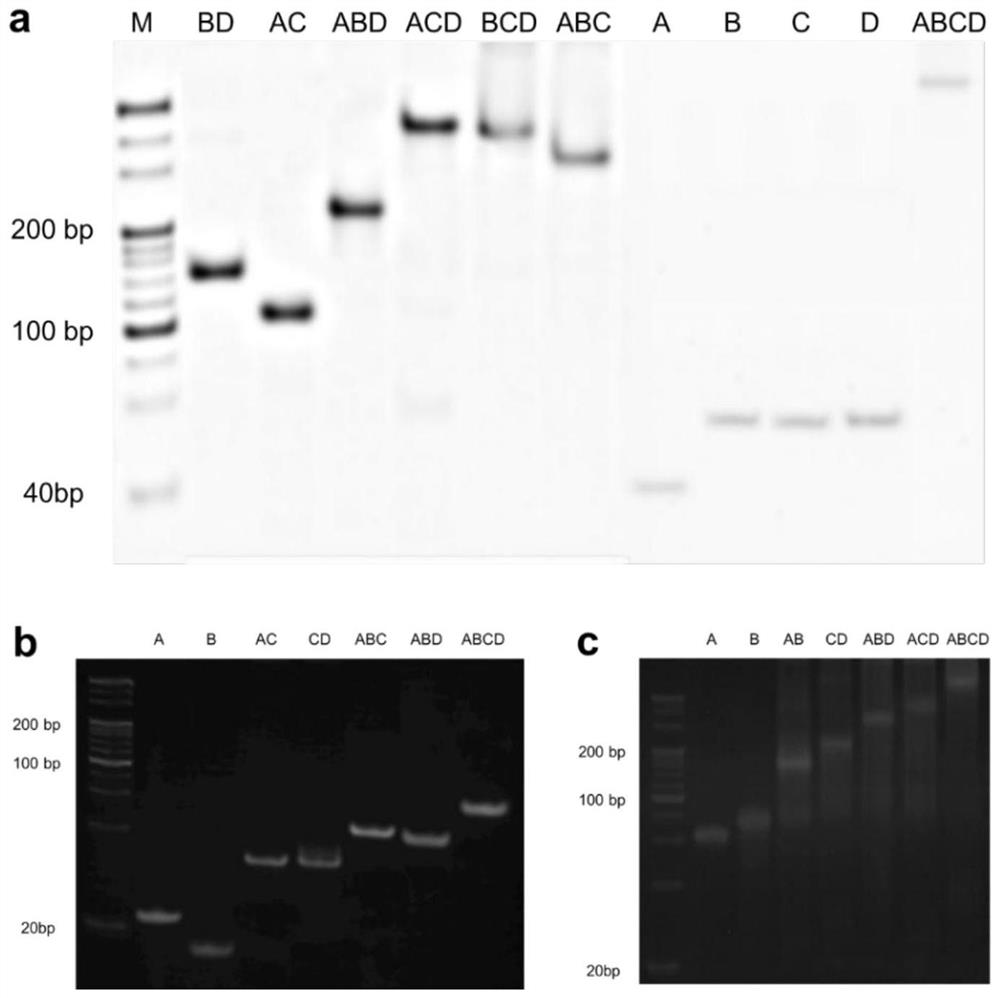Single-particle bioprobe and its construction method for plasma biomemory
A biological probe and plasma technology, applied in the direction of instruments, scientific instruments, measuring devices, etc., can solve the problems of low content of microRNAs, large volume of information storage equipment, etc., to achieve improved mass transfer rate, better and more stable structure, larger size zoom out effect
- Summary
- Abstract
- Description
- Claims
- Application Information
AI Technical Summary
Problems solved by technology
Method used
Image
Examples
Embodiment 1
[0063] This embodiment relates to a method for preparing tsDNA, comprising the following steps:
[0064] The design of tsDNA is based on the principles of complementary base pairing, as few secondary structures as possible and GC content above 50%, and three different sizes of tsDNA with side lengths of 7bp, 17bp and 26bp were designed. For the synthesis of tsDNA, the preparation method can refer to "A DNA nanostructure-based biomolecular probe carrier platform for electrochemical biosensing, Pei H, Lu N, Wen Y, et al. Advanced Materials, 2010, 22(42):4754-4758", the specific method as follows:
[0065] 1. Dissolve each strip of ssDNA, measure the absorption at 220-280nm under an ultraviolet spectrophotometer, obtain the molar extinction coefficient of each strip of ssDNA from Dalian Bao Biological Company, and determine the actual concentration of each strip of ssDNA;
[0066] 2. Mix the four ssDNAs forming tsDNA in equal proportions in TM buffer, add tris(2-carboxyethyl)pho...
Embodiment 2
[0074] This embodiment relates to a method for preparing an indium tin oxide conductive film glass substrate with Au@AgNCs fixed on the surface, comprising the following steps:
[0075] 1. Synthesis of nano-gold seeds: We used a common seed growth method to prepare gold seeds with a diameter of 20-40nm. In order to prepare gold nanoparticles with a diameter of 1-5 nm, first add 0.2-0.8 mL of fresh 5-15 mM sodium borohydride solution prepared in ice water to 5-15 mL of 50-150 mM CTAB and 0.2-0.5 mL of 5- In the mixed solution of 10mM chloroauric acid, the brown solution obtained was kept in a water bath at 20-30°C for 2-5 hours to ensure that the excess sodium borohydride was decomposed completely before use. Then, gold seed solution is made by following method, the 50~200mM ascorbic acid solution of 2~5mL is added in the 100~200mM CTAC solution of 5~15mL and the chloroauric acid mixed solution of 5~10mL 0.2~0.5mM to obtain After stirring evenly, add 0.2-0.5mL of 1-5nm gold na...
Embodiment 3
[0081] This embodiment relates to a method for modifying Au@Ag NCs by tsDNA, comprising the following steps:
[0082] Take 100-200 μL of 1pM tsDNA solution synthesized in Example 1 and drop it on the surface of the indium tin oxide conductive film glass with Au@Ag NCs immobilized in Example 2, and incubate at room temperature for 2-6 hours. Then the excess tsDNA solution was removed with ultrapure water and dried with nitrogen gas to prepare a single Au@Ag NC LSPR probe based on tsDNA.
[0083] Named according to the size of the side length of the tetrahedron, three tetrahedrons with different side lengths of 7bp, 17bp and 26bp are tsDNA 7 , tsDNA 17 and tsDNA 26 . Due to the strong covalent interaction between silver and sulfur, tsDNA with a side length of 17bp 17 For example, such as Figure 7 shown in tsDNA 17 thiol groups are modified on the three vertices of , one of the edges (l 1 ) to leave a section of ssDNA molecules for capturing miR-21 molecules, and on the o...
PUM
| Property | Measurement | Unit |
|---|---|---|
| width | aaaaa | aaaaa |
| electrical resistivity | aaaaa | aaaaa |
| diameter | aaaaa | aaaaa |
Abstract
Description
Claims
Application Information
 Login to View More
Login to View More - R&D
- Intellectual Property
- Life Sciences
- Materials
- Tech Scout
- Unparalleled Data Quality
- Higher Quality Content
- 60% Fewer Hallucinations
Browse by: Latest US Patents, China's latest patents, Technical Efficacy Thesaurus, Application Domain, Technology Topic, Popular Technical Reports.
© 2025 PatSnap. All rights reserved.Legal|Privacy policy|Modern Slavery Act Transparency Statement|Sitemap|About US| Contact US: help@patsnap.com



